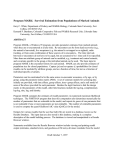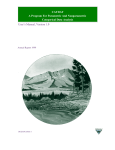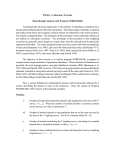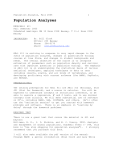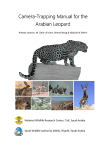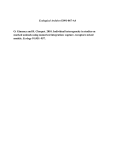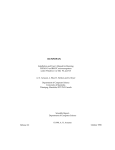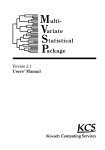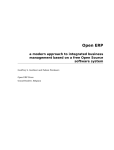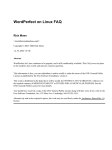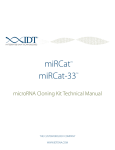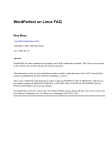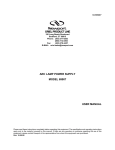Download Program MARK Introduction
Transcript
Introduction Documentation Downloading and Installation Recent Changes
Reporting Problems Workshops Known Problems
Program MARK
Announcements: Upcoming intermediate level workshop at Colorado
State University, Fort Collins, Colorado, USA, 2-6 June, 2003.
Upcoming workshop on advanced techniques
for monitoring animal populations at the 3rd
International Wildlife Management Congress in
Christchurch, New Zealand, 1-5 December,
2003.
The Program MARK hypertext-based online discussion forum,
Analysis of Data from Marked Individuals , is found at:
http://canuck.dnr.cornell.edu/HyperNews/get/marked/marked.html
.
Introduction
Program MARK, a Windows 95, 98, NT, 2000, or XP program,
provides parameter estimates from marked animals when they are
re-encountered at a later time. Re-encounters can be from dead
recoveries (e.g., the animal is harvested), live recaptures (e.g. the
animal is re-trapped or re-sighted), radio tracking, or from some
combination of these sources of re-encounters. The time intervals
between re-encounters do not have to be equal, but are assumed to
be 1 time unit if not specified. More than one attribute group of
animals can be modeled, e.g., treatment and control animals, and
covariates specific to the group or the individual animal can be
used. The basic input to program MARK is the encounter history for
each animal. MARK can also provide estimates of population size for
closed populations. Capture (p) and re-capture (c) probabilities for
closed models can be modeled by attribute groups, and as a function
of time, but not as a function of individual-specific covariates.
Parameters can be constrained to be the same across re-encounter
occasions, or by age, or by group, using the parameter index matrix
(PIM). A set of common models for screening data initially are
provided, with time effects, group effects, time*group effects, and a
null model of none of the above provided for each parameter.
Besides the logit function to link the design matrix to the parameters
of the model, other link functions include the log-log, complimentary
log-log, sine, log, and identity.
Program MARK computes the estimates of model parameters via
numerical maximum likelihood techniques. The FORTRAN program
that does this computation also determines numerically the number
of parameters that are estimable in the model, and reports its guess
of one parameter that is not estimable if one or more parameters are
not estimable. The number of estimable parameters is used to
compute the quasi-likelihood AIC value (QAICc) for the model.
Outputs for various models that the user has built (fit) are stored
in a database, known as the Results Database. The input data are
also stored in this database, making it a complete description of the
model building process. The database is viewed and manipulated in a
Results Browser window.
Summaries available from the Results Browser window include
viewing and printing model output (estimates, standard errors, and
goodness-of-fit tests), deviance residuals from the model (including
graphics and point and click capability to view the encounter history
responsible for a particular residual), likelihood ratio and analysis of
deviance (ANODEV) between models, and adjustments for over
dispersion. Models can also be retrieved and modified to create
additional models.
These capabilities are implemented in a Microsoft Windows 95
interface. Context-sensitive help screens are available with Help
click buttons and the F1 key. The Shift-F1 key can also be used to
investigate the function of a particular control or menu item. Help
screens include hypertext links to other help screens, with the intent
to provide all the necessary program documentation on-line with the
Help System.
The theory and methods used in Program MARK are described in
more detail in an "electronic book".
Sixteen different parameterizations of encounter data are provided
in Program MARK.
Cormack-Jolly-Seber Model
Live recaptures are the basis of the standard Cormack-Jolly-Seber.
Marked animals are released into the population, often by trapping
them from the populations. Then, marked animals are encountered
by catching them alive and re-releasing them. If marked animals are
released into the population on occasion 1, then each succeeding
capture occasion is one encounter occasion. Consider the following
scenario:
Release ----S(1)-----> Encounter 1 -------S(2)------> Encounter 2
Animals survive from initial release to the first re-encounter with
probability S(1), and from the first encounter occasion to the second
encounter occasion with probability S(2). The recapture probability
at encounter occasion 1 is p(2), and p(3) is the recapture probability
at encounter occasion 2. At least 2 encounter occasions are required
to estimate the survival rate between the first release occasion and
the first encounter occasion, i.e., S(1). The survival rate between
the last two encounter occasions is not estimable because only the
product of survival and recapture probability for this occasion is
identifiable.
Generally, the survival rates of the CJS model are labeled as
phi(1), phi(2), etc., because the quantity estimated is the probability
of remaining available for recapture. Thus, animals that emigrate
from the study area are not available for recapture, so appear to
have died in this model. Thus, phi(i) = S(i)(1 - E(i)), where E(i) is the
probability of emigrating from the study area.
Lebreton et al. (1992) develop this model, and use SURGE (Pradel
and Lebreton 1993) to provide parameter estimates. MARK provides
the same capabilities as SURGE, plus additional types of models.
Another program applicable to live recaptures is POPAN, which
provides for estimation of population size and recruitment with the
Jolly-Seber model. A third program is SURPH, which is similar in its
capability to MARK for live recapture and known fate data. None of
the above 3 programs will handle the band recovery models, the joint
live recapture and dead recovery models, robust design model, or the
multi-strata model.
Band Recovery Model
With dead recoveries, marked animals are released into the
population, and re-encountered as dead animals, typically harvested.
This theory has been developed by Brownie et al. (1985). Parameters
estimated are survival rate, S(i), and band reporting rate, r(i),
following Seber (1970). The primary model used by MARK differs
somewhat from the parameterization of Brownie et al. (1985)
because the f(i) of Brownie et al. are reparameterized as (1 S(i))r(i). The primary parameterization of MARK results in better
numerical estimation properties, plus, makes the band recovery
models consistent with the parameterization of the CJS models. In
particular, the use of covariates with the S(i) and r(i) is reasonable,
because each parameter represents a particular process in the the
overall band recovery process (unlike the f(i) parameter of the
Brownie et al. model). However, the last S(i) and r(i) are
confounded. In addition, with the S(i) and r(i) parameterization,
S(i) is always estimated between zero and one. However, when the
estimate of S(i) is at the boundary, i.e., close to or equal to one, the
standard error is not estimated correctly. An equivalent situation
occurs with the binomial distribution when either no successes occur
in the data, or all successes occur in the data, and the standard error
is estimated as zero. Both the S(i), r(i) and S(i), f(i)
parmeterizations of the band recovery model are included in MARK.
Joint Live and Dead Encounters
The joint live and dead model is based on theory developed by
Burnham (1993). The parameter space consists of survival rates [S(i)],
recapture rates [p(i)], reporting rates [r(i)], and fidelity [F(i)]. An
extension developed by Barker (1997) that allows live resightings
during the interval between live recaptures is also available. Barker's
model extends the capability of Burnham's model, plus allows for the
option of no dead recoveries and live recaptures and live resightings.
Known Fate Model
Known fate data assumes that there are no nuisance parameters
involved with animal captures or resightings. The data derive from
radio-tracking studies, although some radio-tracking studies fail to
follow all the marked animals and so would not meet the
assumptions of this model. A diagram illustrating this scenario is
Release -----S(1)----> Encounter 2 -----S(2)----> Encounter 3
-----S(3)----> Encounter 4 ...
where the probability of encounter on each occasion is 1 if the
animal is alive or dead.
Closed Captures Models
The closed captures models allow the modeling of the initial
capture probability (p) and the recapture probability (c) to estimate
population size (N). This data type is the same as is analyzed with
Program CAPTURE (White et al. 1982). All the likelihood models in
CAPTURE can be duplicated in MARK. However, MARK allows
additional models not available in CAPTURE, plus comparisons
between groups and the incorporation of time-specific and/or
group-specific covariates into the model.
The main limitation of Program MARK for closed capture-recapture
models is the lack of models incorporating individual heterogeneity.
Individual Covariates cannot be used with the closed captures data
type because animals that were never captured (and hence, whose
individual covariates could never be measured) are incorporated into
the likelihood as part of the estimate of population size (N). Models
that can incorporate individual covariates existing in the literature
(Huggins 1989, 1991) have been implemented in MARK. Estimates of
population size are given for the Huggins' models, but these estimates
are not quite as efficient as the closed captures data type where the
statistical models are equivalent to those in Program CAPTURE.
However, the ability to incorporate individual covariates makes the
Huggins' models more appropriate if individual heterogeneity exists in
the data.
Robust Design Models
Robust Design Models are a combination of the CJS live recapture
model and the closed capture models, and are described in detail by
Kendall et al. (1997, 1995) and Kendall and Nichols (1995). Instead
of just 1 capture occasion between survival intervals, multiple (>1)
capture occasions are used that are close together in time. These
closely-spaced encounter occasions are termed "sessions".
For each trapping session (j), the probability of first capture (p(ji))
and the probability of recapture (c(ji)) are estimated (where i
indexes the number of trapping occasions within the session), along
with the number of animals in the population (N(j)). For the
intervals between sessions, the probability of survival (S(j)), the
probability of emigration from the study area or more precisely, the
probability of the animal not being available for capture on the jth
occasion given that it was available on the j-1st occasion (gamma' '
(j)), and the probability of staying away from the study area or the
probability of an animal not being available for capture on the jth
occasion given that it was not available for capture on the j-1st
occasion (gamma' (j)) are estimated. Indexing of these parameters
follows the notation of Kendall et al. (1997). Thus, gamma' '(2)
applies to the second trapping session, and gamma' (2) is not
estimated because there are no marked animals outside the study
area at that time. To provide identifiability of the parameters for
the Markovian emigration model, Kendall et al. (1997) suggest setting
gamma' ' (k-1) = gamma' '(k) and gamma'(k-1) = gamma'(k), where k is
the number of trapping sessions. To obtain the "No Emigration"
model, set all the gamma parameters to zero. To obtain the "Random
Emigration" model, set gamma'(i) = gamma' '(i).
The main limitation of MARK for robust design models is the lack of
models incorporating individual heterogeneity in the estimation of
population size. Individual Covariates can be used to model the
parameters S, gamma' ', and gamma' in the Robust Design data type.
Individual Covariates cannot be used with the Robust Design data
type for the p's, c's, and N's because animals that were never
captured (and hence, whose individual covariates could never be
measured) are incorporated into the likelihood as part of the
estimate of population size (N). Models that can incorporate
individual covariates existing in the literature (Huggins 1989, 1991)
have been implemented in MARK. Estimates of population size are
given for the Huggins' models, but these estimates are not quite as
efficient as the closed captures data type where the statistical
models are equivalent to those in Program CAPTURE. However, the
ability to incorporate individual covariates makes the Huggins' models
more appropriate if individual heterogeneity exists in the data.
Multi-strata Models
The multi-strata model of Brownie et al. (1993) and Hestbeck et
al. (1991) allows animals to move between strata with transition
probabilities. At this time, only the movement model without
memory is implemented. An extension to the multi-strata model to
include dead recoveries is also implemented.
Jolly-Seber Models
Jolly-Seber Models (Jolly 1965; Seber 1965, 1982, 1986, 1992;
Pollock et al. 1990, Schwarz and Arnason 1996) extend the CJS live
recaptures models to include recruitment into the populations. In
addition to the apparent survival and recapture probabilities of the
Cormack-Jolly-Seber model (recaptures only model), the Jolly-Seber
model allows estimation of the population size (N) at the start of the
study, plus the rate of population change (lambda) for each interval.
Also included in MARK are the 3 models developed by Pradel (1996)
where only recruitment is estimated, both recruitment and apparent
survival are estimated, and apparent survival and rate of population
change are estimated.
Nest Survival Model
Estimation of nest survival has been a problem of interest since
the Mayfield estimator. The nest survival model implemented into
MARK allows estimation of daily nest survival rates as a function of
both time of season and age of nest. The nest survival model is also
useful for "sloppy" radio-tracking datasets, where all animals in the
radioed population are not checked simultaneously, as required for
the known fate model.
Occupancy Models
Estimation of the proportion of sites occupied is a common
problem in ecology. MacKenzie et al. (2002) have formalized the
model to incorporate the probability of detection of a species at a
site. MacKenzie et al.'s model, plus a robust-design extension, have
both been implemented into MARK.
Encounter Histories
The Encounter Histories File is the file that contains the encounter
histories, i.e., the raw data needed by Program MARK. Format of the
file depends on the data type and examples are given in the help
file. The convention of Program Mark is that this file name must end
in the INP suffix. The root part of the file name dictates the name of
the dBASE file used to hold model results. For example, the input file
MULEDEER.INP would produce a Results File with the name
MULEDEER.DBF and 2 additional files (MULEDEER.FPT and
MULEDEER.CDX) that would contain the memo fields and index
orderings, respectively. MULEDEER.CDX will be erased upon exit
from MARK.
Encounter Histories Files do not contain any PROC statements, but
only encounter histories or recovery matrices. You can have group
label statements and comment statements in the input file, just to
help you remember what the file contains. The interactive interface
adds the necessary program statements to produce parameter
estimates with the numerical algorithm based on the model specified.
Once the encounter histories file is created with an ASCII text
editor, the next step is to execute the program and select File, New.
You then enter the number of Encounter Occasions, number of
Groups, and the Data Type. After this input is provided, the
Parameter Matrices are created, one for each parameter and group.
These matrices default to Time matrices, which you can then modify
to other possibilities using menu options. If you don't need any
additional constraints, which can be specified via the Design Matrix,
then choose the Run menu option to produce the numerical
estimates. The Run Window has additional requests for input,
including the Run Title, Model Name, Time Intervals, and Encounter
Histories File Name. When you click the OK button to run compute
the numerical estimates, you must wait for this process to complete
before proceeding. At that time, a Results data base will be created
(if you request it), and the output stored in the data base for
comparison with other models you may provide.
The input file for the example data from American Fisheries
Monograph No. 5 (Burnham et al. 1987) is provided as
AFSMONGR.INP. This data set has 5 re-encounter occasions, 2
groups, and is live recapture data. Specify these values when you
start the program from the File | New menu choices. In the Run
Dialog Window, select the AFSMONGR.INP file as the Encounter
Histories Input File. Alternatively, the results database for this
example is also included with the program. Use the File | Open
menu choices to open this file, and review the model results
provided.
Documentation
No paper documentation is available for MARK. Electronic
documentation is provided in the Windows 95 help file that
accompanies the program and available here as HTML files. Open up
the Help document with the program, and read some of the
documentation, or check out the HTML version. You can print any of
this material if you really want hard copy.
A reasonably complete description of Program MARK was developed
for the Euring 97 conference, available as a PDF file. I consider this
paper as the primary citation for Program MARK:
White, G.C. and K. P. Burnham. 1999. Program MARK:
Survival estimation from populations of marked animals.
Bird Study 46 Supplement, 120-138.
An "Introductory User's Guide to MARK" is being developed by Evan
Cooch at Cornell University. For the complete novice, this is the
place to start to learn how to run MARK. This guide is a work in
progress, so is not complete just yet.
Notes concerning the theory and use of MARK from the graduate
course that David Anderson and Gary White teach at Colorado State
University: FW663, Analysis of Vertebrate Populations, are
available. This is the same material provided as "Technical
Background" from Evan's site referenced in the preceding paragraph.
A set of slides that illustrate the concepts of MARK is available for
viewing. These slides give a general overview, and portions of them
are used in the slide talks listed below.
A one day workshop on Program MARK was given at the Second
International Wildlife Management Congress in Gödölló, Hungary, July
2, 1999. The following are the slide talks given:
Introduction to Program MARK -- Gary C. White
Exploring Ecological Relationships in Survival and Estimating
Rates of Population Change Using Program MARK -- Alan B.
Franklin
The Robust Design for Capture-Recapture Studies: Analysis
using Program MARK -- William L. Kendall
Jointly Analyzing Live and Dead Encounters using MARK -Richard J. Barker
Advanced Features of Program MARK -- Gary C. White
In addition, the following papers are to be published from this
workshop.
First Steps with Program MARK: Linear Models -- Evan Cooch
Exploring Ecological Relationships in Survival and Estimating
Rates of Population Change Using Program MARK -- Alan B.
Franklin
The Robust Design for Capture-Recapture Studies: Analysis
using Program MARK -- William L. Kendall
Jointly Analyzing Live and Dead Encounters using MARK -Richard J. Barker and Gary C. White
Advanced Features of Program MARK -- Gary C. White, Kenneth
P. Burnham, and David R. Anderson
One of the problems with obtaining software from the Web is that
hard copy documentation is not available, such as is the case for
Program MARK. The following sites provide information on how to
cite electronic documents: MLA-Style Citations of Electronic Sources
and Electronic Sources: APA Style of Citation .
Downloading MARK
New Version 1 September 2002
I developed a new version of the MARK interface with a new Visual
Objects compiler on 1 September, 2002. Thus, to use this new
version, you must download the 9 disk files as described below (or
the one CDROM disk file as described). The update file is only
compatible with the version of MARK after 1 September, 2002. A
common error that occurs when you have mixed versions of the code
(i.e., the DLL files are not completely compatible with the EXE file)
is an error from Kernal32.DLL, particularly on NT machines.
New Version 22 November 2002 -- replace the version of 1
September 2002
Turns out that the new version of the Visual Objects compiler was
causing more problems than it solved. In particular, users were not
able to open previously created MARK files that had large outputs
associated with them. Thus, I've had to go back to the previous
version of the Visual Objects compiler, which will aggravate the
problem of mixed versions of the code on a single machine. I suggest
you uninstall MARK and then reinstall from scratch the setup.exe file
described below, to insure that you don't end up with
incompatibilities between the DLL files and the MARK_INT.EXE file.
Copy the single setup.exe file to your hard disk, and execute it to
install MARK. This setup file should place a MARK icon on your
desktop, register the graphics package, and put the examples
distributed with the program in an Examples subdirectory under the
Mark directory. If you have difficulty copying a single large file, the
setup has been broken down into 7 pieces: setup.exe, setup.2,
setup.3, setup.4, setup.5, setup.6, setup.7, setup.8, and setup.9.
Copy down these pieces and install MARK by executing the setup.exe
file.
Note that any of the setup files, are available via anonymous ftp
from ftp.cnr.colostate.edu in the pub/mark subdirectory, in case you
are having problems with your browser copying down the files. The
single large file is in the cdrom/disk1 subdirectory, the 9-part setup
files are in 144mb/disk1 through 144mb/disk9.
If you have a recent download installed, you can update just the
critical files by installing them from update.zip.
Windows ME and XP Setup Problems
Some folks are having difficulties downloading MARK onto Windows
ME and XP operating systems. The problem concerns the setup.exe
program wanting to create a file entitled TGETUP9 when ME or XP
already has one. Here's the work around from Jon Runge:
1. Through Window Explorer go to Tools: Folder Options:
View. Check the "show hidden files and folder" box and uncheck the
"hide protected operating system files" box.
2. Go to the folder C:\WINDOWS:\TEMP. Rename TGSETUP9.TMP to
something like TGSETUP~9.TMP.
3.
Run Setup.exe for MARK.
4.
When done, go back and restore TGSETP9's original name.
Mac and Linux Machines
To run MARK on a Mac (from Evan Cooch):
Equipment Tested: Macintosh PowerBook G3 (Lombard) 333 MHz with
192 MB of ram (note that Mac clock speed numbers are NOT the same
as Windows/Intel clock speeds, i.e., a 333 MHz Mac is faster than a
comparable WinTel machine).
Software: Virtual PC version 3.0.3 with Windows 98. Able to use
MARK under VirtualPC with Windows 98. Also able to use Microsoft
Access under VirtualPC.
Recommendations: The more ram you have the better. Set your
VirtualPC program's memory to as much ram as you can afford. The
emulator program (VirtualPC) actually runs Windows using the amount
of ram that you set aside for the emulator. I set the Virtual PC to
use 69MB of memory and find that this allows Windows/Dos software
to run as fast as a real contemporary WinTel machine. Also, I've had
best results running the Mac OS with an abbreviated set of
Extensions. You can easily do this by creating a reduced Extension set
with the Extension Manager (this is a Control Panel).
To run MARK on a Linux machine (from Len Thomas):
Software: VMWare -- a BIOS emulator for both Linux and WinNT that
effectively lets you run one or more "virtual computers" inside your
current operating system. So, for example, you can open a Win95
window from your linux box, and everything within that window
thinks its in Windows 95. Of course you do need a Win95 license for
this, but at least it gets around the problem of wanting to run linux
for most things, but having some legacy software in windows.
Many people use VMWare because they do most things in linux (SPlus,
C++, F90), but then some people want or have to use MS Office for
their word processing, for example. I use it the other way around: I
do most things in WinNT (Visual Basic, etc), but need to be able to
test my programs in "vanilla" Windows NT, 98, 95, 2000 systems, so I
can run these inside my main machine.
Communication between virtual computers is via virtual networking.
At this time MARK has never been tested under VMWare in linux, but
MS Office works, so MARK is expected to work.
Recent Changes
Recent changes include the following:
April, 1998
1. Making the PIM Chart interactive, so that you can edit the PIM's
by dragging blocks of parameters, or by right-clicking on a block and
changing the PIM. This feature makes for rapid editing, and also
allows editing of very large PIMs without actually opening up the PIM
Window and all the edit boxes.
2. The design matrix now allows you to paste in a block of values
contained in the clipboard. Either use the Ctrl+V command, or else
select the Paste Clipboard command.
3. The robust design model now has a saturated model value
computed, although I'm not quite sure its correct. However, without
a saturated model value, the deviance was computed as zero, so that
likelihood ratio tests were not possible. Turns out that some data
sets still have a zero deviance, meaning that the saturated model
deviance is not correct. The AIC values are okay, just the deviance is
wrong.
4. Barker's model has been thoroughly checked, and seems to work
correctly. Note that the model has been re-parameterized compared
to earlier versions. See the Help file for details.
May, 1998
5. Because the identity design matrix is the default, I made the
program "smarter" so that an actual matrix does not have to be
passed between the interface and the numerical analysis program,
and not stored in the output. Instead, the key work "identity" is
added to the design matrix statement. No design matrix is printed
in the output. More importantly, no design matrix pops up on the
screen when you retrieve a model that had the "identity" key word on
the design matrix statement.
6. I have modified the calculation of the threshold value for
declaring a parameter not estimable. The old threshold value was
0.3E-6. The new value varies depending on the dimension of the
variance-covariance matrix. Thus, some models may give a different
number of parameters estimated than previously. If you find an
error, let me know so that I can continue to refine this process.
June, 1998
7.
Seven new models were added to the list of data types:
Huggins (1991) method where the closed captures likelihood is
conditioned on only the animals captured has been added. This
model allows individual covariates to be used for estimating the
initial (p) and recapture (c) probabilities of the closed capture
model. Estimates of population size (N) are generated as derived
parameters, because N does not actually occur in the likelihood with
Huggins' model as it does in the closed captures models of Program
CAPTURE. Estimates of N are asymptotically equivalent to estimates
of N from the closed captures models of Program CAPTURE, but are
not quite as efficient because some information is lost by
conditioning the likelihood.
Huggins (1991) method was also added to the robust design model, so
that individual covariates can also be used with all the paramters.
The Jolly-Seber model has been added. The first parameterization is
from Ken Burnham, and uses the first population size N1 and the rate
of population change, lambda1 through lambda(k-1) for k encounter
occasions. This model does not converge readily, so I suggest you
use one of the Jolly-Seber models described below.
Pradel's (1996) model that estimates seniority from the encounter
histories has been added.
Pradel's (1996) model that estimates both seniority and apparent
survival from the encounter histories has been added. This model is
another parameterization of the Jolly-Seber model.
Pradel's (1996) model that estimates apparent survival and rate of
population change (lambda) has been added. Again, this model is
another parameterization of the Jolly-Seber model.
Pradel's (1996) model was reparameterized to include apparent
survival and fecundity (number of new individuals in the population
at time i+1 per individual at time i). Again, this model is another
parameterization of the Jolly-Seber model.
8. The Graphics Server graphics package was added as the default
graphics package. The reason for this second graphics package was
to provide better graphics when multiple sets of parameters were
displayed. Both packages are available via from the Results Browser
Window with the Output | Specific Model Output | Interactive
Graphics and the Output | Specific Model Output | Interactive
Graphics GS menu choices.
May, 1999
9. The variance components code was changed to use the full
precision of estimates for the variance-covariance matrix. You will
have to recompute parameter estimates of existing models to use the
new code.
10. The older graphics package was eliminated. This change cut
the size of the program distribution files.
11. An option to re-compute all the models in a Results Database
was appended to the Run menu of the Results Browser.
June, 1999
12. PIM matrices can now be copied to the clipboard, and vice
versa the clipboard can be pasted into a PIM. This feature also
means that you can create PIMs in a spreadsheet, and then paste the
values into a PIM Window (or also on the PIM chart).
13. An "All Different Matrix" option has been added to the PIM
menus to allow you to create PIMs with every value different.
14. The Full menu choice has been changed when you request a
Design Matrix. Now, the Full menu choice produces a design matrix
with an intercept, group effects (if needed), time effects, and
group*time effects (if needed). The limitation of the Full option is
that the PIMs must have the number of parameters equal to a full g*t
model. However, you can create age structure across PIMs, and still
use the Full menu choice as long as the number of parameters is
equal to a full g*t model. The columns of the design matrix are
initially labeled, although these labels disappear if you manipulate
the matrix, e.g., add or delete columns. I'm thinking about how to
keep the labels around.
The old version of the Full menu choice has now been renamed to
be a the Identity menu choice.
15.
The list of Pre-Defined Models has now been expanded to
include both PIM and Design Matrix coding of the standard models. In
addition, the Design Matrix coding list includes g+t models. All the
Design Matrix models are constructed based on a full g*t set of PIMs.
Hence, you still can't use the Pre-Defined Models option to construct
age-structured models.
16. A menu choice has been added to the Output menu to list the
m(ij) arrays of live recaptures and dead recoveries of the encounter
history matrix in a NotePad window. This option is useful for
identifying anomalies in the data. In the past, you could only run
RELEASE for the CJS model to look for anomalies.
17. Variance components outputs are further developed, with
additional options specified by check boxes for output other than the
main numerical output and the graph of the estimates.
18. The problem with a semicolon in the encounter histories file
between comment delimiters, e.g.,
/* stuff; stuff */,
has been fixed.
19. Problem behavior with the individual covariate standardization
method has been uncovered. When you specify a model with a
common a common intercept but 2 or more slopes for the individual
covariate, e.g.,
1 weight 0
1 0 weight
and specify to standardize the individual covariate, you will get a
different value of the deviance than from the model run with
unstandardized individual covariates. This behavior is because the
centering effect of the standardization method affects the intercept
differently depending on the value of the slope parameter. The
effect is caused by the nonlinearity of the logit link function. You
get the same effect if you standardize variables in a logistic
regression, and run them with a common intercept. The result is
that the estimates are not scale independent, but depend on how
much centering is performed by subtracting the mean value.
20. I think I have gotten rid of the problem that caused the message
"Unique ID > 8000. Tell Gary". If you still get this message with the
new version, let me know.
July, 1999
21. The ability to open one of the last 4 files previously used has
been added to the File menu.
22. Real parameter estimates are now labeled as "Estimates" instead
of "S(I)" in the output.
23. An option was added to make the default to tell you when a
model is retrieved. With the File | Preferences menu choice, you
can change this option back to not making you respond to this
message.
24. The option to list the Akaike Weights in the Results Browser has
now been made the default. You can turn this option off with the
File | Preferences menu choice.
December, 1999
25. A problem with losses on capture in estimating p and c of the
robust design and Huggins robust design models has been fixed.
Previously, S, gamma'', and gamma' were estimated correctly with
losses on capture, but not p and c, and hence N.
26. Options for export of parameter estimates (both beta and real),
and SE's and confidence intervals to Excel spreadsheets or the
clipboard were added.
27. Options for export of variance-covariance matrices to dBase files
or the clipboard were added. These changes forced a re-organization
of the menu choices under Output | Specific Model Output to keep
the menu from becoming too clumsy. Also, the model averaging
variance-covariance matrix can now be exported to a dBase file.
28. Extensive testing of the Jolly-Seber model demonstrates that it
works correctly, but is just difficult to achieve convergence with for
sparse data. With simulations and large sample sizes, it works fine.
29. More work was done on the simulation procedure. However, I
still have not removed the double-click trap to keep the faint of
heart out of the simulation procedures. I now believe that all models
are simulated correctly except the robust design, Huggins robust
design, and Pradel model with recruitment but no survival.
Currently, you are not allowed to simulate these models. All the rest
should work correctly, including the Jolly-Seber model. The problem
with simulating the robust design models is how to specify the
poulation size so that it is not less than what is consistent with the S,
gamma'', and gamma' parameters for the previous interval and
preceding N. This problem involves fixing the input interface, not
the actual numerical simulation procedure.
March, 2000 (updated to Version 1.7)
30. A "robust design" extension of the Barker model is now included
in MARK.
31. A VPA - Virtual population model - is now included.
32. The ability to submit simulations to Program RELEASE is included
in the Simulation menu.
33. The ability to submit simulations to Program CAPTURE is included
in the Simulation menu.
34. The design matrix now displays different colors for cells with
zero, one, and other values. This feature is handy for spotting the
pattern in complex matrices. You can change the colors displayed
with the File | Preferences menu choice.
35. The ability to run more than one data type within the same
Results Browser window has been implemented. For example, you
can now run both the dead recoveries {S, r} models and the Brownie
et al. {S, f} models, and have the results appear in the same Results
Browser window. To change the data type for models, select the PIM
| Change Data Type menu choice from the Results Browser window.
This convenience also introduces some problems, such as model
averaging (not all the models have the same PIMs), so that the model
averaging procedure only averages across the models with the same
data type. Another example of where problems occur is when the
likelihoods are very different between the data types, e.g., the
closed captures models and Huggins' models. The AIC values are not
on the same scale for these different data types. However, this
feature is very useful to compare the 2 sets of estimates from the
same Results Brower window. With this change, I updated the
version number of MARK to 1.7.
36. An option to use multi-threading was added to the File |
Preferences menu choice. This option allows you to be building a
new model while numerical estimation is running for a previous model
in background.
37. An option was added to the Run Window that specifies to use the
mean values of individual covariates to compute the real parameter
estimates reported in the output. Note that when individual
covariates are standardized, the mean value for a standardized
covariate is zero.
June, 2000 (updated to Version 1.8)
38. The "robust design" extension of the Barker model was modified
to include the permanent emigration (F) parameter, and the notation
for the temporary emigration parameters was changed to be gamma''
(old F) and gamma' (old F') to be consistent with Lindberg et al. (In
Press).
39. Calls to Programs ESTIMATE and BROWNIE were added to the
Test menu choice in the Results Browser window. The programs are
useful in assessing goodness-of-fit for dead recovery data.
40. The capability to "undelete" a model that was deleted from the
Results Browser window was added. This menu choice is available
under the Delete menu of the Results Browser window. You are
presented with a list of all the models you have deleted during this
execution of MARK, and allowed to select the models you want to
undelete. However, once you end MARK, the deleted models
permanently disappear.
41. A "Partial Zero" menu choice was added to the Design Matrix
window to allow the user to "clear" or zero out a portion of a
column. This option is useful when you copy a column, and only want
to retain a portion of the values in the column.
42. The variance components output was modified to include a naive
estimator of the process variance. Additionally, the estimate of the
process variance and associated confidence intervals are now
reported with negative values, if necessary. However, the estimate of
the process standard deviation is reported as zero for negative
process variances (and similarly for the lower confidence bound).
43. A new column has been added to the Results Browser -- Model
Likelihood. The values in this column are the Akaike weight of the
model in the row divided by the Akaike weight of the minimum AICc
model. This value is the model likelihood, the strength of evidence
for the model. The best model has a value of 1, with all other
models <1.
44. The Variance Components module now has a check box to run
the Random Effects model that corresponds to the variance
components analysis you have requested. Specifically, a Random
Effects model can be viewed as intermediate in its number of
parameters between the time-specific model (t) and the dot (.)
model where all values are the same. The approach developed by
Ken Burnham is to fix the parameter values that were used to
estimate the process variance to their S-tilde values from the
variance components analysis. The number of parameters that this
set now represents is estimated from the trace of the G matrix.
Adding trace(G) to the number of parameters estimated from the
numerical analysis run with fixed values from the S-tilde gives the
number of parameters estimated for the random effects model.
Because trace(G) is not an integer, the number of parameters for the
random effects model appears as a non-integer. To accommodate
these non-integers, existing Results Files will be updated
automatically the first time they are accessed. You should see a
message stating so. To be safe, you may want to back up your MARK
files before opening them with this new version.
45. Although the background colors used in the design matrix to
represent the pattern of the matrix are very helpful, especially at
first, the cost is a lot of time watching design matrices being created
on the screen. Therefore, I put an option in the File | Preferences
dialog to turn off the color in design matrices if you desire, which
definitely increases speed for large matrices.
46. I fixed a bug with the probability of surviving the study
(Kaplan-Meier estimate) for the Known Fate data type when time
intervals were unequal. Previous versions assumed all time intervals
were equal to 1. Now, the length of the time interval is used to
compute the product of survivals and its standard error and
confidence intervals.
47. Labels for the real parameter estimates are now provided in the
output. Labels for real parameter estimates are taken from the
"Parm" column that is added to the design matrix -- giving you some
idea about what the parameter type is for each estimate. Note
however, that some parameter types can be set to others, e.g.,
initial capture probability (p) and recapture probability (c) in the
closed capture models. Hence, be careful to not be mislead. You do
not need a design matrix to obtain these labels -- the process is
automatic. Labels are generated from the parameter type for the
first occurence of the parameter index in the PIMs. If you want to
obtain these labels for existing model output, you need to re-run the
model, i.e., from the Results Browser, Run | ReRun Models menu
choices. The real parameter estimate labels are limited to 20
characters.
48. Labels for the beta parameter estimates and columns of the
design matrix are now available. When in the design matrix, if you
right-click the matrix, the menu choice "Label" allows you to enter 20
characters of information to include in the column heading of the
column with the highlighted cell. If you start with the Design | Full
menu choice, the headings in the design matrix will be automatically
labeled. Likewise, the pre-defined design matrix models also have
the columns automatically labeled. When the model is run, this
information is passed to the numerical estimation process, and these
labels will appear beside the beta parameter estimates. When
models are retrieved, the design matrix column headings also are
retrieved from the output.
49. Columns in the design matrix can be moved by dragging the
column heading to a new position. The new ordering can be
preserved by right-clicking the design matrix and selecting "Reorder
Columns" from the pop-up menu. Basically reordering columns is
equivalent to renumbering the beta parameters.
August, 2000
50. A bug introduced in June concerning parsing of real parameter
estimates from the output file when derived parameter estimates
were present was fixed. This bug was detected because of incorrect
output in the model averaging procedure when derived parameter
estimates were present.
September, 2000
51. The computer time required to process individual covariates has
been dramatically reduced, at least 10 times.
52. A bug with the naive variance component estimator has been
fixed -- previously, 2 consecutive runs of the variance components
module would give incorrect estimates for the naive estimator for
the second and additional runs.
January, 2001
53. The variance components estimator has been modified to show
estimates of sigma^2 < 0, then to set the estimate of sigma to zero,
and re-compute the beta-hats and their standard errors with sigma =
0.
54. Likelihood ratio tests when c > 0 have been modified to
incorporate the quasi-likelihood parameter. Likewise, the deviance is
now displayed in the results browser is corrected for c.
55. Design matrix window now has an option to set the font size,
so that large matrices can be miniaturized and the colors used to
determine if the pattern is correct.
56. Derived parameters are now handled separately from the real
parameter estimates. Eventually, derived parameters will be a
fully-supported third parameter type, and you will be able to graph
them and perform variance components.
May, 2001 (updated to Version 2.0 -- Greater Prairie Chicken photo)
57. Two additional data types for closed captures have been added.
Two heterogeneity models for closed captures have been created
based on mixture distributions. The simple version of this model only
has a constant capture probability for all occasions and for
recaptures. The full heterogeneity model has a set of p and c
parameters for each mixture. Encounter histories for these 2 models
are identical to the closed captures data type. These models
required a fairly major change to the PIM structure to allow for large
rectangular PIMs.
58. A model for nest survival estimation was added. This model is
different from the known fate data type because the exact time of
failure of the nest is not known. Input for nest survival data can be in
the form of a nest survival data type, where the time of first finding
the nest, next to last time the nest was observed, and the last time
the nest was observed are entered, followed by the fate of the nest
(0=successful, 1=unsuccessful). Individual covariates may also be
used. More details on the structure of this model and the encounter
histories file can be found in the help file.
59. A bug that caused incorrect standard errors for the derived
parameter estimates of N was fixed in the Huggins robust design
model.
60. Some really large problems (e.g., very large PIMs or a large
number of PIMs) will not work correctly with the existing model
averaging parameter selection interface. Therefore, I added another
interface that will work. To use this new interface, click the "Use
non-interactive model averaging parameter specification window"
choice from the File | Preferences menu choice. With this interface,
you have to pick the PIM and then specify the parameter within the
PIM to model average. Not as visual, but more effective for large
problems.
June, 2001
61. A bug in computing the variance of the derived parameter
estimate N-hat for the Huggins data type was fixed. Standard errors
of N-hat from the Huggins models now correspond closely with
standard errors from the closed captures data types.
62. The scaling of the gamma'' and gamma' for the length of the
interval was removed. These parameters should be viewed as the
probability of being available for capture conditional their previous
status, and hence are not a function of the length of the time
interval.
63. When setting up a new analysis, you can now paste in time
interval lengths from the clipboard. Thus, if you have a complicated
set of time intervals, enter them into a spreadsheet, and then paste
the values into MARK.
64. A "Save As" capability was added to the File menu choice to save
a copy of the current Results File.
65. The dialog to select a set of "Pre-defined Models" has been
re-written to allow the user to pick models for each parameter,
rather than select from a list of all possible models. This change
allows pre-defined models for data types that previously would
generate too long of potential models, allows the user to more easily
select just models desired, and makes it harder to "Select All"
models. In other words, rather than shamelessly data dredging with a
few mouse clicks, you will now have to work at it!
66. The ability to summarize derived parameters from simulations
was added.
67. Several bugs that caused incorrect estimates for the nest survival
data type were fixed.
July, 2001
68. The nest success data type was further modified to produce
warnings when invalid data are entered for a nest record. The help
file under the 'Nest Survival' topic was updated to present examples
of these invalid cases.
September, 2001
69. The multi-strata model with live and dead encounters is now
working correctly after another bug was fixed on 3 September, 2001.
The help file has also been updated to describe this model.
November, 2001
70. The occupancy estimation model of MacKenzie et al. (2002) has
been implemented. The help file has also been updated to describe
this model.
January, 2002
71. Minor fixes to several bugs that have surfaced, including aborts
when no pre-selected models are selected, incorrect label on beta
labeling window, and specification of default preferences when the
program is installed.
March, 2002
72. The Run Window has been modified to allow a user to specify
values of individual covariates to be used in computing the real
parameter estimates. With these changes, 3 options are available for
specifying values of the individual covariates: values from the first
encounter history in the encounter histories file, mean values, and
values the user specifies.
73. Paste buttons were added to the simulation input screens for
beta parameter estimates and numbers of releases, and initial input
screens for group labels, individual covariate names, and strata
names and labels. Now, the user can generate a set of input values
for any of these screens in a spreadsheet, and then paste the values
into MARK.
74. The Run Window has been modified to allow a user to specify
different link functions for parameters in a model. However, this
procedure is tricky, and can lead to numerical problems if not done
intelligently. Default initial parameter values are more difficult to
set, so numerical convergence becomes more of an issue. The user
will have to take more responsibility in specifying initial parameter
values if multiple link functions are used in one model.
September, 2002 -- Version 3.0
75. The robust-design occupancy estimation model of MacKenzie et
al. (submitted) has been implemented.
76. An updated Graphics Server graphics package has replaced the
older version. The interface to the graphics package now includes
legends for each set of parameters plotted.
77. Some minor bugs with labeling columns in the design matrix,
PIM Charts off the top of the screen, and some other little
annoyances that have been pointed out have been fixed.
78. The capability to construct interaction terms between
individual covariates has been implemented with the product
function in the design matrix. In addition, an add function has also
been implemented. See the revised help file for details of how these
functions operate within the design matrix.
79. The Pearson chi-square statistic is now computed routinely in
the full output, and can be saved in the simulation and bootstrap
files. The Pearson chi-square statistic is sometimes better behaved
than the deviance statistic, and may provide an improvement in
estimating the over-dispersion parameter, c.
November, 2002 -- Version 3.1
80. An entry in the design matrix menu now allows you to see the
list of individual covariates available for the current data set, and to
insert 1 or more of these individual covariate names in the current
highlighted cell in the design matrix.
81. Added the capability to retrieve one or more columns from a
previous model's design matrix and insert them into the current
design matrix. Note that the number of rows in the design matrix has
to be the same for both design matrices.
December, 2002
82. An option was added to the Run Window to allow estimation of
profile likelihood confidence intervals for real parameters. However,
numerical problems can cause the estimates to be wrong, so use this
option carefully. The help file explains the procedure, and shows an
example of incorrect profile likelihood confidence intervals.
March, 2003
83. The multinomial logit (MLogit) and cumulative logit (CLogit)
link functions were added as options under the Parm.-Specific link
function option of the Run Window. The MLogit link is particularly
useful for the multi-strata model to constrain the transitions from a
strata to sum to <=1. Another application is the probability of entry
parameter of the POPAN model (see below). See the revised link
functions help file write-up for details.
84. The POPAN model was revised, and is now working correctly for
the real parameter values. This is the Jolly-Seber model from
Schwarz and Arnason (1996), where recruitment to the population is
modeled as the probability of entry (pent in MARK, beta in the
original paper) from a super population.
85. Problems with convergence of the robust design occupancy
model were corrected, plus 2 additional parameterizations of this
model were added. See the help file for details.
86. An additional parameterization of the Jolly-Seber model
developed by Link and Barker (submitted to Biometrika) was added.
To use this parameterization, start with one of the other Jolly-Seber
data types (e.g., Burnham's Jolly-Seber data type, one of the 3
Pradel data types, or the POPAN data type), and use the PIM |
Change Data Type menu choice to obtain the Link-Barker
parameterization. Details are in the help file.
June, 2003
87. Fixed a bug in the Huggins closed-capture heterogeneity models
so that N is correctly estimated.
August, 2003 -- Version 3.2
88. There are 6 different data types for estimation under the
closed capture models: Mt (p and c), Mh (pi and p) and full Mh (pi,
p, and c); with each of these data types available with population
size (N) in the likelihood, or a Huggins version where the likelihood
does not contain N. Now, when the Closed Captures data type is
selected, you are given a choice of which of these models of capture
probabilities to use for your initial model. However, you can select
different data types with the Change Data Type menu choice that is
available under the PIM menu. Note that the likelihood for the
Huggins models is not comparable to the likelihood for the data types
that include N in the likelihood, so that AIC model selection should
only be done within the 2 categories, not between them.
89. These same 6 closed models are now available for the robust
design model, as well as the robust design version of Barker's model.
When you select either the robust design, or the Barker robust
design, you are asked to select one of the 6 closed models. However,
you can change the closed model with the Change Data Type menu
choice.
90. The robust design multi-strata model has been added to MARK.
The open model of Kendall and Bjorkland (2001 Biometrics
57:1113-1122) has been added, along with a closed version that can
operate with any of the 6 closed models described above. When you
select the closed robust design multi-strata data type, you are asked
to select one of the 6 models, but you can change between them
with the Change Data Type menu choice.
91. A new version of the installation program was used that has
caused some difficulty, but seems to be working correctly.
Reporting Problems
For questions or to let me know about problems you have
encountered, send email. Please try to provide as much
documentation as possible to help me duplicate your problem. In
particular, I would like to have the input file that caused the
problem, and the values you entered for the number of occasions,
the number of groups, and the data type. Further, if you have
created a results file, please send this via MIME or uuencode. Both
the *.DBF and *.FPT files must be forwarded -- both are needed to
see the models you have built.
Upcoming Workshops
An alternative to a week-long workshop is to take FW663, Analysis of
Vertebrate Populations, a 5-credit graduate course taught by David R.
Anderson and Gary C. White in alternate spring semesters at Colorado
State. Out-of-state tuition for the course is approximately $2,700,
and cheaper for Colorado residents. The class meets MWF from 8-12
from mid-January until the first of April. The class will next be
taught spring semester, 2004, beginning mid-January and ending
early April.
Another intermediate level workshop is scheduled for June 2-6, 2003,
in Fort Collins, Colorado.
Formal Coursework
Individuals desiring a comprehensive treatment of the background
material of Program MARK, and gaining a familiarity with using the
program, are encouraged to take the course FW663, Sampling and
Analysis and of Vertebrate Populations, co-taught by David R.
Anderson and Gary C. White. The course meets from mid-January
until the first week of April, MWF from 8-12. The class will next be
taught spring semester, 2002, beginning January 14 and ending March
29. We strongly encourage students from outside the University to
participate in this course.
Known Problems
Some known problems that you should be aware of:
1. The deviance for the closed captures model divided by its
degrees of freedom is not a valid estimate of c-hat. This
problem carries over to the robust design model. I believe the
problem is because these models are not in the exponential
family, and this type of estimate of c-hat is only valid for
models in the exponential family. This problem also extends
to the robust design model.
2. The deviance is not a good test of the goodness-of-fit of the
model for sparse data. Sparse data may result from few
releases, but even with lots of releases and a large number of
encounter occasions, the data will be sparse. Sparse data
result in small expected values for lots of the capture
histories. To have observed a capture history, at least 1
animals must have been observed with this history. For a
small expected value, the contribution to the deviance is
large, i.e., (1 - Expected)^2 / Expected is large. A pooling
algorithm does not seem possible that will fix this problem.
To obtain a valid test of the goodness-of-fit of the model, and
an appropriate estimate of c-hat, a parametric bootstrap
procedure has been implemented in the Tests menu choice.
3. When you run several numerical estimation jobs at once, the
program often aborts after you've appended one of these jobs
to the Results Database. You can still retrieve the results from
the remaining jobs by using the Output | Append menu item to
open the MRK????Y.TMP temporary files. This problem is caused
by bugs in the Visual Objects compiler having to do with the
dynamic allocation of memory for multiple threads.
4. Program MARK is not particularly stable, mainly because of
limits on the amount of available memory. Suggestions for
improving the stability of the program are to maximize the
amount of memory (RAM) available to the program by closing
other jobs, closing PIM windows within MARK when through
with them, and occasionally restarting the program to free any
memory tied up in memory leaks. The more memory you
have, the more stable the program is.
Literature Cited
Barker, R. J. 1997. Joint modeling of live-recapture, tag-resight,
and tag-recovery data. Biometrics 53:666-677.
Brownie, C., D. R. Anderson, K. P. Burnham, and D. S. Robson. 1985.
Statistical inference from band recovery data - a handbook, 2nd ed.
U.S. Fish Wildl. Serv. Res. Publ. Num. 131, Washington, D.C. 305pp.
Brownie, C., J. E. Hines, J. D. Nichols, K. H. Pollock, and J. B.
Hestbeck. 1993. Capture-recapture studies for multiple strata
including non-Markovian transitions. Biometrics 49:1173-1187.
Burnham, K. P., D. R. Anderson, G. C. White, C. Brownie, and K. H.
Pollock. 1987. Design and analysis methods for fish survival
experiments based on release-recapture. Amer. Fish. Soc. Monograph
5:1-437.
Burnham, K. P. 1993. A theory for combined analysis of ring recovery
and recapture data. Pages 199-213 in J.-D. Lebreton and P. M. North,
editors. Marked individuals in the study of bird population. Birkhauser
Verlag, Basel, Switzerland.
Hestbeck, J. B., J. D. Nichols, and R. A. Malecki. 1991. Estimates of
movement and site fidelity using mark-resight data of wintering
canada geese. Ecology 72:523-533.
Huggins, R. M. 1989. On the statistical analysis of capture-recapture
experiments. Biometrika 76:133-140.
Huggins, R. M. 1991. Some practical aspects of a conditional
likelihood approach to captureexperiments. Biometrics 47:725-732.
Kendall, W. L., J. D. Nichols, and J. E. Hines. 1997. Estimating
temporary emigration using capture-recapture data with Pollock's
robust design. Ecology 78:563-578.
Kendall, W. L., and J. D. Nichols. 1995. On the use of secondary
capture-recapture samples to estimate temporary emigration and
breeding proportions. J. Applied Statistics 22:751-762.
Kendall, W. L., K. H. Pollock, and C. Brownie. 1995. A
likelihood-based approach to capture-recapture estimation of
demographic parameters under the robust design. Biometrics
51:293-308.
Jolly, G. M. 1965. Explicit estimates from capture-recapture data
with both death and immigration stochastic model. Biometrika
52:225-247.
Lebreton, J.-D., K. P. Burnham, J. Clobert, and D. R. Anderson.
1992. Modeling survival and testing biological hypotheses using
marked animals: case studies and recent advances. Ecol. Monogr.
62:67-118.
MacKenzie, D. I., J. D. Nichols, G. B. Lachman, S. Droege, J. A.
Royle, and C. A. Langtimm. 2002. Estimating site occupancy when
detection probabilities are less than one. Ecology 83:2248-2255.
Pollock, K. H., J. D. Nichols, C. Brownie, and J. E. Hines. 1990.
Statistical inference for capture-recapture experiments. Wildlife
Monographs 107. 97pp.
Pradel, R. and J.-D. Lebreton. 1993. User's manual for program
SURGE. Version 4.2. Centre D'Ecologie Fonctionnelle et Evolutive,
C.N.R.S., Montpellier-Cedex, France. 33pp.
Pradel, R. 1996. Utilization of capture-mark-recapture for the study
of recruitment and population growth rate. Biometrics 52:703-709.
Schwarz, C. J., and A. N. Arnason. 1996. A general methodology for
the analysis of capture-recapture experiments in open populations.
Biometrics 52:860-873.
Seber, G. A. F. 1965. A note on the multiple recapture census.
Biometrika 52:249-259.
Seber, G. A. F. 1970. Estimating time-specific survival and reporting
rates for adult birds from band returns. Biometrika 57:313-318.
Seber, G. A. F. 1982. The estimation of animal abundance and
related parameters. 2nd ed. Macmillan, New York, USA. 654pp.
Seber, G. A. F. 1986. A review of estimating animal abundance.
Biometrics 42:267-292.
Seber, G. A. F. 1992. A review of estimating animal abundance II.
Reviews of the International Statistics Institute 60:129-166.
My colleagues have lost consciousness over MARK.
If you don't use WordPerfect, you may not have the WPMathA fonts
used in some of the PDF documents provided above (which may result
in various equations being unreadable). You can install the needed
fonts from Corel by going to
http://www.corel.com/6763/downloads/WordPerfect/wpwin/9/wpfonts.exe
, which should solve the problem.
The Program MARK web page has been accessed times since August
16, 2000.
Last updated





















